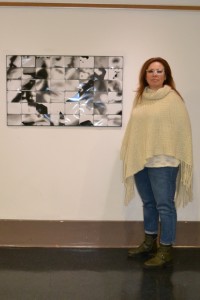Students from Camosun College’s Visual Arts program are displaying their artwork in three spaces around the Lansdowne campus this month. The works will be on display as of February 16 in the entrance foyer of the Lansdowne library, on the second floor of the library, and at a space between Young 111 and 117.
Camosun Visual Arts instructor John Boehme worked with Camosun in order to make the art displays happen.
“Art is an integral way in which we understand ourselves in a complex world,” says Boehme. “The exhibition of works allows for the opportunity to challenge and engage a wider community.”

Nancy Yakimoski, also a Camosun Visual Arts instructor, says it is great to see students who are “so invested” in their program doing what they’re doing “because they want to, not because they have to.”
“Part of this idea,” says Yakimoski about the art installations around campus, “was to gain more visibility by having the work in the library and the hallways where people are coming and going. The students make the art, but then part of my course is to give them the skills to install the work. It’s all very student-centred.”
Yakimoski says she gave her students three options when it came time to do the projects that are being displayed on campus.
“They could take the genre of still life, and then respond in a contemporary way,” she says. “And still life in photography has been making this amazing resurgence in the last five years.”
For the second option, students could take a painting of their choice and respond to it in a modern way, or, as Yakimoski says, “restage it with a twist.” The third option was to do a portrait of an artist, which, Yakimoski says, students found surprisingly difficult.
“A lot of students said, ‘I’ll do that one,’ but to stage a portrait of an artist is really difficult work. Each of the projects had very different demands.”
Yakimoski says one of the best parts of Visual Arts at Camosun is how it displays the diversity around campus.
“Part of the college is dedicated to cultural excellence and also to diversity,” she says. “We have international students in our programs, we’ve got First Nations students; their ideas, coming from such diverse backgrounds, are voices that we get to see articulated in a variety of mediums, which is always exciting.”
Yakimoski says the effect of the art around campus to the average passerby is a subjective experience, but hopefully a unifying one that creates familiarity through the creativity of the work.
“The idea that other people in the college get to see the students’ work and have a moment with it, where you might recognize part of yourself, is great. And it’s always exciting to see part of yourself in somebody’s artwork, in somebody’s writing, in somebody’s performance. I think that just kind of brings us all closer together.”
Camosun Visual Arts student Megan Quigley says the fact that her program is interdisciplinary is both the best and most challenging part of it.
“There are a lot of postsecondary art programs where you go and you study painting, and you study drawing, but because our program is interdisciplinary, it’s more about learning the best tools to enhance your practice, as opposed to becoming a master at one. I find that it takes a lot of flexibility, but it’s also, for me, the most rewarding part of our program, because it’s equipping us to be really versatile in our practice.”
Quigley says that Victoria has “a really rich but fickle” arts community and that she would like to see more of her peers out showing their work.
“I think Camosun is a bit of a well-kept secret in the community,” she says, “and I think the calibre of work is regarded as very high.”
For her project, which will be on display on the second floor of the library, Quigley says she chose to create an abstract series in photography using textiles for subject matter.
“It’s harder to do than you would think it is,” she says with a laugh, adding that it’s important to showcase the art around campus. “Art isn’t meant to be hidden away.”

